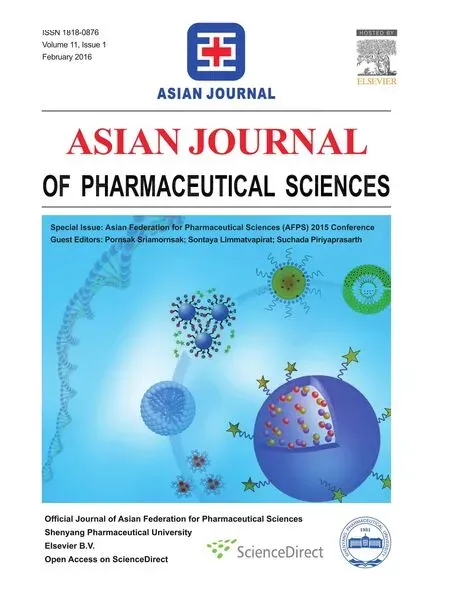Linking the lab to the patient:Tools for optimizing oral drug delivery
b
aGoethe University,Frankfurt am Main 60438,Germany bBiorelevant.com,Croydon,UK
Linking the lab to the patient:Tools for optimizing oral drug delivery
Jennifer Dressmana,*,Mark Berlina,b
aGoethe University,Frankfurt am Main 60438,GermanybBiorelevant.com,Croydon,UK
A R T I C L E I N F O
Article history:
Available online 23 November 2015
Cinnarizine
Atazanavir
Weak bases
Poor solubility
Transfer model
PBPK simulation
Food effects
In the development of new drugs as well as new formulations of existing products(including generic products),it is of great interest to be able to predict to what extent the drug can be absorbed from the gastrointestinal(GI)tract and how the formulation and dosing conditions may affect the absorption profle.The hypothesis behind Biorelevant release testing is that“the closer the test conditions can simulate the gastrointestinal environment,the better the prediction will be.”Typical aspectsofGIphysiology,whichcaninfuencedrug bioavailability,are the composition of the GI fuids(which affects various processes including release from the dosage form and stability of the drug),GI motility and hydrodynamics(transit characteristics of the dosage form,release from the dosage form etc.),and permeability of the GI mucosa to the drug as a function of location in the GI tract,and gut wall metabolism.While release from the dosage form can be addressed with Biorelevant release tests,which seek to reproduce compositional and hydrodynamic conditions at various locations within the GI tract, the interplay of release with gut wall permeability,gastric emptying and frst pass metabolism are diffcult to refect in these in vitro release tests.By coupling the release test results with a physiologically based pharmacokinetic(PBPK)model that details GI physiology as well as post absorptive events in the body,there is great value added in terms of predicting in vivoperformance of the drug.This presentation will highlight the physiological conditions in the GI tract relevant to drug and formulation performance in the fasted and fed states,describe the Biorelevant release test conditions that can be used to simulate these and show two case examples(both poorly soluble weak bases)where coupling Biorelevant release testing with PBPK modelling has successfully predicted plasma profles of the drug after oral administration.

Fig.1–The Berlin Decision Tree for development of poorly soluble weak bases(with copyright permission from M.Berlin).
Acknowledgement
The authors acknowledge the fnancial support received from Merck&Co.,Inc.(LKR120577),Pennsylvania,USA,for the atazanavir studies.
R E F E R E N C E S
[1]Berlin M,Przyklenk K-H,Richtberg A,et al.Prediction of oral absorption of cinnarizine–A highly supersaturating poorly soluble weak base with borderline permeability.Eur J Pharm Biopharm 2014;88:795–806.
[2]Berlin M,Ruff A,Kesisoglou F,et al.Advances and challenges in PBPK modeling–Analysis of factors contributing to the oral absorption of atazanavir,a poorly soluble weak base.Eur J Pharm Biopharm 2015;http://dx.doi.org/10.1016/j .ejpb.2015.03.031.
*E-mail address:Dressman@em.uni-frankfurt.de.
Peer review under responsibility of Shenyang Pharmaceutical University.
http://dx.doi.org/10.1016/j.ajps.2015.10.007
1818-0876/?2016 The Authors.Production and hosting by Elsevier B.V.on behalf of Shenyang Pharmaceutical University.This is an open access article under the CC BY-NC-ND license(http://creativecommons.org/licenses/by-nc-nd/4.0/).
 Asian Journal of Pharmacentical Sciences2016年1期
Asian Journal of Pharmacentical Sciences2016年1期
- Asian Journal of Pharmacentical Sciences的其它文章
- Determination of the antidepressant effect of mirtazapine augmented with caffeine using Swiss-albino mice
- Photosafety testing of dermally-applied chemicals based on photochemical and cassette-dosing pharmacokinetic data
- Biopharmaceutics classifcation system(BCS)-based biowaiver for immediate release solid oral dosage forms of moxifoxacin hydrochloride (Moxifox GPO)manufactured by the Government Pharmaceutical Organization(GPO)
- Bioequivalence study of abacavir/lamivudine (600/300-mg)tablets in healthy Thai volunteers under fasting conditions
- Evaluation of cytotoxic and infammatory properties of clove oil microemulsion in mice
- Analytical method development of pregabalin and related substances in extended release tablets containing polyethylene oxide
